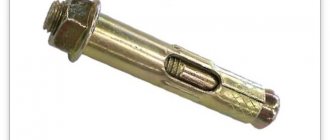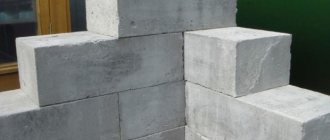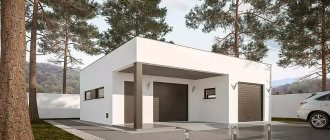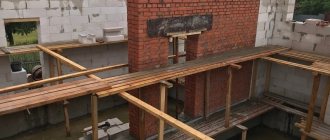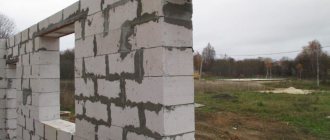- Chemical
In recent years, cellular concrete has become a breakthrough in the building materials market, because it is impossible to achieve the same thermal conductivity from heavy concrete. In low-rise construction, they began to use not only blocks, but also monoliths made of foam and aerated concrete, from which durable and warm walls are obtained. But due to the inverse relationship between thermal conductivity and strength, they are not able to withstand too much load. This is not only the weight of the structures above, but also the pullout forces that act on the wall or ceiling when hanging heavy objects. Aerated concrete anchors, the variety of which will be presented in the article, will help solve this problem.
Design features of fasteners for cellular concrete
When choosing fasteners for aerated concrete, you need to pay attention to the following parameters:
- How dense are the wall blocks? The density marking is indicated in the form of numbers after the letter D. The larger the number, the fewer pores in the material, therefore, the greater the density. The load limit when pulling out fasteners depends on these indicators. They can be found in the instructions that are sold complete with the material.
- Fastener parameters. This refers to length and diameter: the larger the indicators, the higher the ability to withstand loads. These parameters are also indicated in the instructions for the material.
- How resistant the material is to corrosion. This parameter needs to be given special attention if the fasteners will be installed on the outside of the garage or in a room where it is constantly cold. In this case, it is necessary to choose hardware that will be covered with protection.
- Selection of tools. It is recommended to choose tools that do not involve impacts during the installation process (for example, a hammer will not work). The best solution would be a hand drill, a special punch or a brace.
- Correct installation. Even the strongest fasteners do not guarantee results if they are installed incorrectly.
Tool and surface features
Installation tools:
- electric hand drill;
- drill bit with pobedite tip;
- hammer;
- a wrench or screwdriver for screwing in a screw;
- adhesive mixture for chemical anchor;
- special gun for glue mixture.
The main condition when installing objects and accessories is the correct choice of hardware.
Aerated concrete, having a porous structure, is a relatively fragile material, so the question arises - what kind of hardware is needed to ensure that the fastening is reliable and meets all the operating requirements of the structure.
There is a wide range of products that make it possible to fasten structures reliably and quickly.
From the video below you will learn about fasteners for aerated concrete.
Fastening requirements
There are also a number of requirements for fastening elements:
- They must be selected taking into account the environment. If the room is too humid or the temperature is constantly changing, the highest quality fasteners are needed, preferably with a zinc coating. The location of use is also taken into account here. For example, in a heated garage or outside.
- It is important that the chosen fastenings do not create tension within the elements.
- They must not contain toxic agents.
Why does foam concrete need special fasteners?
Foam blocks are made from water, sand, cement and a special foaming agent. The blocks are cellular, the material is fragile enough for installation of various fasteners.
The main distinctive features of foam blocks: low weight, low density, high level of hygroscopicity, porous structure. For the most part, properties act as advantages during the construction and operation of buildings, but not at the moment of attaching some objects to the walls.
The structure of foam concrete is porous, the adhesion to materials is not very good, so the blocks cannot always cope with the loads, and therefore special dowels are provided for them.
Properly selected fasteners for foam blocks will not only secure equipment or furniture with high quality, but will also strengthen the working structure and significantly increase the percentage of permissible loads.
Fasteners for foam blocks require a certain design of fixing parts - they usually consist of the following elements: a screw, a ring, a half-ring, a side, an empty sleeve with a spacer. Many anchors are made with teeth, which become a reliable obstacle to the part turning.
There are also chemical anchors for foam blocks, which are created specifically for use and provide maximum quality of fastening. In this case, the main task of the dowel is to create internal support in the block during the expansion process inside the aerated concrete and preserve the fragile material from destruction.
Dowels can be of different diameters and lengths, made of metal or plastic, and are supplied in packs of 50-1000 pieces. According to the scope of application, they are intended for external/internal work, according to the installation method - driven, screwed and others (chemical anchors are distinguished separately).
Mounting options
The fasteners used to fill the holes include resins:
- epoxy;
- epoxy acrylate;
- polyester;
- vinylester.
The choice of fasteners is also influenced by factors such as:
- terms of Use;
- environment;
- composition of the adhesive material.
Types of fasteners:
- dowel;
- anchor;
- self-tapping screw;
- spiral nail.
Each variety has its own pros and cons. The installation process for all fasteners is generally similar. The difference is in the materials from which they are made. Some can only withstand light loads, while others can withstand any weight, including large equipment.
Dowel
There are several types of dowels. Among them are:
- Dowel nail. Manufacturing material – steel. As the smooth nail enters the sleeve, the base begins to open. As a result, it enters the material at an angle. These fasteners can be used for all types of concrete.
- Facade universal. With its help you can attach facade panels to aerated concrete. It is also used for attaching wall shelves and cabinets.
- Universal nylon spacer. This dowel option is suitable for small weight items. For example, curtains and curtains, small shelves, switches, baseboards and cables.
- Frame. It is suitable for attaching wall cabinets, door and window frames to aerated concrete.
- Nylon. Made specifically for aerated concrete. It is mounted together with a simple self-tapping screw. Most suitable for wood or metal based façade systems, doors, windows, suspended ceilings, piping and sanitary fittings.
- Steel dowel coated with zinc. Suitable for any type of concrete. Can be used for almost all attached objects. The material can withstand the heaviest loads, and the zinc coating makes the fastening resistant to corrosion.
Mechanical anchor
A mechanical anchor for aerated concrete is ideal for massive structures. For example, pipes, air conditioners, water heaters, massive cabinets. Withstands the same load as a steel dowel, but due to the lack of zinc coating, it is more susceptible to corrosion. Mechanical anchors are also called butterfly anchors due to their shape.
Chemical anchor
A chemical anchor bolt is suitable if you need to fix a heavy object. The principle of operation is the same as that of mechanical anchors, but here you will need to use glue during the installation process. Thanks to this technique, it is possible to achieve reliable fixation in objects with low density, including:
- Gas silicate partition.
- Porous brick.
- Foam concrete slab.
Features of application
To install a mechanical sleeve in aerated concrete, you must follow the following rules:
- The drilled hole is cleaned of dust for better fixation.
- The depth of the hole must be greater than the fastener. The spacer will open properly if part of the screw remains outside.
When installing chemical anchors for aerated concrete, the prepared hole is filled ¾ with glue, otherwise it will come out when the steel rod is inserted. If you do not first clean the hole from dust and debris, the adhesive will not work. The hardening time of the glue depends on its composition, temperature and humidity of the environment and ranges from 2-15 minutes to 12-24 hours.
Fastening building structures to aerated concrete
In general, the process of installing fasteners is similar for all options. First of all, a hole is made, and then the cartridge is inserted. The only difference can be with a chemical anchor, since it uses glue.
Chemical anchors are secured as follows:
- Preparatory work. You need to drill a hole using a drill.
- Next, the hole needs to be cleaned of dust. To do this, use a brush or a medical bulb.
- A cartridge with a chemical composition is installed. To do this, you need to insert a capsule with glue into the recess. The last one is squeezed out.
- An anchor is screwed into the hole.
- You need to wait until the glue dries. There are times when you need to wait 2 days for complete drying. It all depends on the composition, but temperature, humidity and other environmental features are also considered important factors.
- Once the compound has hardened, you can install the washer and nut.
The installation process using a mechanical anchor, dowel nail or self-tapping screw is the same, but without the use of glue.
This is what the fastening looks like inside aerated concrete.
Video on the topic:
Each fastening method has its own advantages and disadvantages. When choosing, you should take into account the material, density, and characteristics of the room.
Did you manage to solve your problem using the recommendations from the article?
Yes!
46.21%
No. More answers required. I'll ask in the comments now.
38.35%
Partially. There are still questions. I'll write in the comments now.
15.45%
Voted: 751
Aerated concrete anchor - what is it?
Translated from German, the term “anker” means “anchor”. This name was given to hardware products intended for fixing any structure to the base. This is an independent fastener that has a spacer part, which changes its shape and size when the connection is formed. It can also have a cuff, due to which the body of the anchor is held in the correct position and does not fall into the drilled hole.
There are three main types of anchors, which differ fundamentally in the method of fastening:
- Due to the frictional force when the walls of the anchor are pressed tightly against the base (wedge).
- Due to the different shape of the hole in the base, and the increasing body of the anchor (expansion).
- By filling the hole with a liquid component that subsequently hardens (chemical anchors for aerated concrete).
Anchors are made from metals and their alloys, as well as polymer fibers: nylon, nylon, polyester, polyamide.
Characteristics of the anchor for aerated concrete
An anchor bolt for aerated concrete belongs to the category of mechanical fasteners and can have a varied appearance. However, this does not change the essence of the fastening: almost always, with rare exceptions, a hole of a given depth and diameter is pre-drilled. A metal sleeve with cut wedges or a notch is hammered into it, a core is screwed into it, due to which the wedges expand or the shape of the sleeve changes.
- Such anchors are capable of holding significant loads, which will allow you to hang an air conditioner unit, boiler or satellite dish on a wall made of aerated concrete. It is only important to correctly correlate their weight with the dimensions and characteristics of the fasteners. A mechanical anchor for a gas block has a significant drawback - high cost. It depends on the size of the anchor and can reach 900-1000 rubles per piece.
- In addition, the wedges expand the block from the inside, thereby creating local zones subject to stress and promoting the appearance of hairline cracks in them. If moisture gets into them, as well as into the mounting recess, the structure of the aerated block may collapse when frozen.
- In this regard, a chemical anchor for aerated concrete is more reliable, the price of which may be much lower. You also need to drill a hole under it, but instead of a metal cylinder, the reagent in a capsule is immersed in it - or squeezed out of the tube using a mounting gun.
- The core is installed in a still plastic mass, after solidification of which it is firmly fixed in a given position. In this case, the glue not only does not create localized loads, but also makes the walls of the hole stronger.
It is impossible to remove an already hardened anchor without destroying the block. If he vomits under too much weight, it will be along with a piece of the wall. Accordingly, a chemical anchor for aerated concrete is used once, while mechanical fasteners can be dismantled without problems.
It is impossible to remove an already hardened anchor without destroying the block. If he vomits under too much weight, it will be along with a piece of the wall. Accordingly, a chemical anchor for aerated concrete is used once, while mechanical fasteners can be dismantled without problems.
Selection requirements
Fastening elements for aerated concrete blocks must meet the following requirements:
- The density of aerated concrete must correspond to the characteristics of the fasteners.
- The length and load-bearing capacity of fastening elements should be selected based on the static load on the gas block when installing furniture.
- The corrosion properties of fasteners must correspond to the conditions in which the house is planned to be used.
Under no circumstances should you make a hole for a dowel by gouging it out, since only by drilling can the strength properties of the material be preserved.
Varieties
There are several types of fasteners, the installation principle is the same, the difference is what type of resin serves as the basis for the fixing composition. The base can be one of the following resins:
- Epoxy acrylate. The composition based on this resin is widely used, has all the properties of the resins described below, in addition - fire resistance (after 2 hours of intense burning the anchor is not in danger of deformation), resistance to frost. The time for complete hardening of the composition is 15-180 minutes.
- Polyester. The main area of use is fastening facade elements, installing utility networks, and fences. To install an anchor for aerated concrete, a conical drill is mainly used; polyester reagents fix only threaded rods. There is no styrene in the composition, the dowels are suitable for external and internal work. The solution completely hardens in 25-180 minutes - the determining factor is the air temperature.
- Vinylester. Universal composition - suitable for threaded and smooth rods. Can be used in conditions of high humidity, and also does not contain styrene - this guarantees increased safety of the anchor. Vinylester resin reagent within 15-24 hours.
- Epoxy. Used when working with concrete class C20/25 and higher. The main areas of application are installation of technical equipment, road barriers, work with beams. The final hardening time is from 7 to 48 hours, depending on the air temperature. Among the distinctive characteristics, it is worth mentioning the following: moisture resistance, the possibility of installation both outside and inside the room, the absence of additional load on aerated concrete, the possibility of fastening with smooth reinforcement, and the absence of styrene in the composition.
Return to contents
Where is the frame anchor used?
This fastener has traditionally been used to install wooden window frames and doors. It is also called a frame dowel. Nowadays, the use of frame anchors has expanded significantly. Technical parameters allow it to be used to solve various problems. The main purpose is to create a through hidden fastening.
Scope of application of the fastener:
- installation of window frames and door structures - attaching the frame and frame to the wall;
- attaching a wooden block to the base when arranging the floor;
- fixation of finishing material, plastic elements;
The fastener is not designed for increased loads; the weight of the object attached with one fastener should not exceed 28 - 30 kg.
Types of fasteners and performance of work
The type of product is selected depending on the expected load:
- for fastening hanging mirrors or lamps, nylon dowels with a cross-section of up to 12 mm are suitable;
- when installing pipelines and bulky objects, choose metal parts;
- frame types of fastenings are used to fix window and door frames;
- universal facade dowels are used when installing external profiles for facing slabs;
- Only light objects are attached to wood screws - photo frames or decorative elements.
Installation is carried out in several stages.
In order for the products to fit tightly into the base, it is necessary to drill the holes correctly. To do this, it is best to use a hammerless drill or a hammer drill with the impact turned off. The drill should have a cross-section 1 mm smaller than the fastener itself. The only exception is steel hardware. For them, the hole will be reduced by 2 mm.
After cleaning the recess from concrete dust, install a dowel. The plastic fastener is screwed in using a screwdriver. Metal parts are driven into the mounting hole with a hammer. During the work, it is necessary to ensure that the product does not warp.
At the final stage, screw in a self-tapping screw or a standard mounting bolt. In this case, it is not advisable to use an electric tool, since when connecting to an aerated concrete block, the screw element may be damaged.
Pros and cons of use
Chemical anchors have a lot of advantages over other types of fasteners, the main ones are:
- absence of destructive pressure on the walls of the liner - the chemical composition, on the contrary, strengthens the structure;
- the location of the fastener is completely Germanized;
- the cost is much lower than that of conventional mechanical dowels;
In turn, there are several disadvantages. Firstly, this is the time it takes for the chemical composition to harden. There is a possibility that during this time the hairpin will deviate somewhat from a straight line. Secondly, to dismantle the anchor after the composition has hardened, it is necessary to destroy a section of the block. For example, to remove a mechanical dowel, you just need to unscrew the rod and easily pull out the plastic sleeve.
Return to contents
